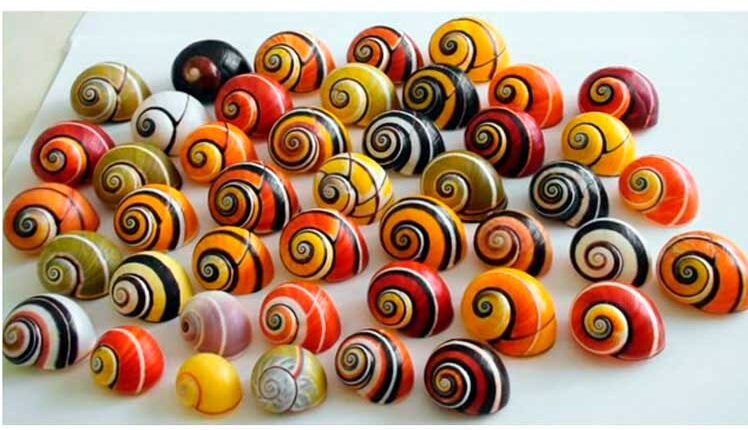
Cuba’s ‘painted snails’ crowned most beautiful, and Mollusk of the Year
The Cuban Painted Snail has won an international competition – and will now have its DNA blueprint unravelled and the key to its beauty unlocked, potentially helping to protect this iconic species from extinction.
Scientists in the UK and Cuba have been campaigning for the eye-catching snail to be crowned winner of the Mollusk of the Year 2022 – an international public vote led by the Senckenberg Nature Research Society, the LOEWE Centre for Translational Biodiversity Genomics (TBG) and the Worldwide Society for Mollusc Research.
There were five finalists in the competition – three snails, one mussel and a tusk shell or scaphopod. The Painted Snail won with a staggering 10,092 votes, taking 62% of the total votes overall. As a reward for winning, its entire genome will now be sequenced at the LOEWE Centre TBG in Germany.
The Cuban Painted Snails, which are only found in Eastern Cuba, are known for their eye-catching coloured shells, which come in a variety of colours, and their ‘love dart’ – a device they use to stab mating partners. They live in a wide variety of habitats, from xerophytic shrub woodland to rainforests.
Cuba is home to perhaps the world’s greatest diversity of snails, but none have shells with such a range of colours and complex patterns as the Painted Snail, or Polymita picta. Sadly, this makes them appealing to collectors and poachers, who sell the shells to tourists or trade them abroad. Their habitat is also under threat, meaning the species is now critically endangered (according to the Cuban Red list for invertebrates).
Professor Angus Davison, from the School of Life Sciences at the University of Nottingham, joined forces with Professor Bernardo Reyes-Tur at the Universidad de Oriente, Santiago de Cuba, to campaign on behalf of the Painted Snail. The duo hope to better understand how this snail evolved, and ultimately, promote their conservation.
The pair will now be able to get the snail’s entire genome sequenced, which will enable both research and conservation – from understanding the evolutionary origin of the snails and their vibrant shell colours, to their ecology. As these Polymita snails are under threat of extinction, genomic resources will also help guide appropriate conservation measures, ultimately protecting this iconic species and as an umbrella to protect other species in the same habitat.
Professor Davison said: “Thanks to everyone who voted. I am so delighted that this most beautiful snail has been crowned “Mollusk of the Year 2022”. Snails don’t always get the attention that they deserve, even though they are important ecologically and as molluscs are part of one of the most diverse groups of animals on earth. The prize – an assembled whole genome sequence – will enable us to begin research on understanding the snail’s biology.
“Unfortunately, Cuban Painted Snails are at risk because of habitat loss, and illegal trade to shell collectors and tourists. The prestige of the win will draw attention and give further impetus to conservation efforts.”
Professor Reyes-Tur says: “When I found out that Polymita had won with over 10,000 votes, I felt so grateful to the people who helped us win, both in Cuba and overseas. Our research team is not only happy, but so grateful to each person who voted.
“We hope that the genome sequencing of the Cuban Painted Snail will benefit the conservation of these amazing snails and the other nearly 1400 Cuban land snail species.
“The genome sequencing could help resolve some intriguing questions. For example, how many species of Polymita are there, and are there really five subspecies of Polymita picta? Getting this basic taxonomy is crucial for conservation. Why is the shell so variable in this species and a similarly colourful European snail, Cepaea nemoralis? What are the genes involved in making the colour? Why do both species stab ‘love darts’ when they mate? The genome sequence will be a golden opportunity to answer some of these questions, promote conservation, and collaborate with research teams around the world.”
“We are pleased that the Cuban painted snail was selected. Its genome will be able to provide us with important information about the genetic basis of the colour variations of its shell,” jury member Dr Carola Greve, laboratory manager at the LOEWE Centre TBG, said.
“In the case of mollusks, there are so far only a few species whose genome has been completely sequenced – and this despite the fact that they form the second largest animal phylum after arthropods,” adds Dr. Greve.


